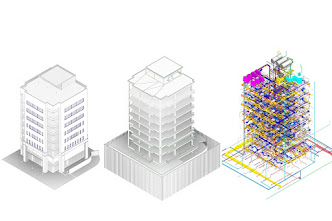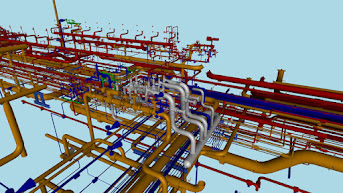Understanding The Role of CAD Software in Steel Fabrication Drawings.
The building industry cannot function without steel manufacturing. Steel is a key component in building strong and long-lasting structures, including skyscrapers and bridges. Creating accurate drawings that direct the fabrication process is an essential step in bringing these designs to life. CAD (Computer-Aided Design) software has completely changed how steel fabrication drawings are produced and used in recent years. We'll examine the value of CAD software in Steel Fabrication Shop Drawings Services and examine how it contributes to the production of Structural Steel Fabrication Drawings in this blog.
What Are Steel Fabrication Drawings?
Let's define steel fabrication drawings first before delving into the use of CAD software. Detailed blueprints and diagrams known as "steel fabrication drawings" give instructions on how to manufacture and assemble steel parts for various building projects. These designs are crucial for both fabricators and erectors since they act as a guide for making structural steel parts and precisely assembling them on the job site.
The dimensions, shapes, materials, and connections of various steel parts, such as beams, columns, trusses, and girders, are often detailed in steel fabrication drawings. To guarantee the caliber and security of the finished building, these designs must be accurate and thorough. These designs were previously produced manually, which was laborious and prone to error process.
What are the Steel Fabrication CAD Drawings?
steel construction A thorough digital representation of a steel structure or component is a Steel Fabrication CAD Drawings. Utilizing specialized computer-aided design (CAD) software, these drawings are produced. They provide a detailed instruction manual for fabricators, manufacturers, and engineers on how to create a steel-based structure.
These drawings offer a thorough blueprint for the fabrication process since they contain detailed information on dimensions, materials, and components. They display the precise dimensions, angles, and connections required for the precise fabrication of the steel parts.
Simply put, they are like extremely comprehensive maps that specify every step for the personnel working with steel, guaranteeing that the finished product is built correctly and adheres to the original plan. They aid in minimizing mistakes, cutting down on waste, and guaranteeing the finished building is sturdy, long-lasting, and constructed according to precise requirements.
What are the he Role of CAD Software in Steel Fabrication Drawings:
Software for computer-aided design (CAD) makes it possible to efficiently and accurately design and detail steel structures, which is essential for steel manufacturing drawings. CAD software is used in steel manufacturing drawings for the following reasons:
Detailing and Drafting:
CAD software is a crucial tool for creating thorough and accurate fabrication drawings, giving steel fabricators clear instructions on the precise methods for cutting, shaping, and putting together various components. These thorough drawings include vital details on welds, hole locations, precise measurements, and acceptable tolerances, providing smooth communication between the design and manufacturing teams and facilitating the successful completion of the intended structure made of steel.
Developing and Visualising:
With the help of CAD software, engineers and designers can create complex 2D and lifelike 3D models of steel buildings that help them picture the finished product. The process of identifying design abnormalities and making necessary changes before the fabrication phase is triggered is made easier by this feature.
Reliability and precision:
Utilizing CAD software ensures accurate geometric representations and rigorous measurements of steel components. This improves overall efficiency and quality assurance by lowering the likelihood of mistakes during the fabrication and assembly processes.
Modification of Materials:
By accelerating the optimization of material use, CAD software efficiently reduces waste and boosts cost-effectiveness. The software rapidly calculates the required steel lengths and specifications, enabling precise resource allocation and material planning, and ultimately supporting the execution of a project that is both affordable and environmentally friendly.
Modelling Parametrically:
Many CAD software programs have parametric modeling capabilities, allowing users to easily change particular design elements like dimensions with automated updates across all related components. In addition to streamlining the design process, this dynamic feature also reduces the chance of errors, establishing an agile and responsive design environment that encourages effectiveness and accuracy throughout a project.
Structural Analysis:
Engineers can assess the load-bearing capability and general safety parameters of the steel structure using certain CAD software programs that are prepared to perform basic structural evaluations. This important component is crucial in ensuring that the design complies with strict safety requirements and, as a result, the structural integrity and robustness of the finished structure.
Interoperability:
The seamless import and export of various file formats are frequently supported by CAD software, making it easier to collaborate with other software platforms and specialists working on the project, such as architects, structural engineers, and firms. This functionality promotes increased communication and coordination among heterogeneous teams involved in the building process and facilitates effective data interchange.
Controlling revisions:
Using CAD software makes it simple to track and manage design revisions, providing a crucial method for dealing with changes made during production or in reaction to site conditions. This feature is essential for providing smooth coordination and synchronization across design iterations, improving the workflow's adaptability and reactivity, and ultimately assisting in the achievement of the project's goals.
Budget Prediction:
Through thorough calculations that account for materials, labor, and other necessary costs that are all generated from the complexity of the design, CAD software offers precise cost estimation for steel fabrication projects. This feature supports the creation of thorough project budgets, encouraging informed decision-making and exact resource allocation, and supporting cost-effective project management and successful execution within predetermined financial constraints.
Compatibility with CNC machines:
It is possible to create machine-readable files using CAD software for Computer Numerical Control (CNC) devices, which are essential for precisely cutting, drilling, and shaping steel components. By seamlessly integrating with CNC technology, the software makes it possible for the accurate and efficient fabrication of complicated steel structures with a focus on precision and quality. This is done by facilitating the seamless translation of extensive design specifications into executable instructions.
Documentation and Records:
The entire design process is captured in a comprehensive digital archive created by CAD software, serving as a useful resource for documentation, compliance, and future reference. A culture of continuous improvement and knowledge preservation is promoted by this strong record-keeping capability, which not only makes it easier to comply with legal requirements but also acts as a trustworthy resource for retrospective analysis, allowing stakeholders to follow the development of the project, make educated decisions, and gain insights for future endeavors.
a summary of CAD software plays a crucial role in the steel fabrication sector by providing unmatched support for accurately and effectively designing, detailing, and documenting steel structures. It must promote improved collaboration among many stakeholders in the construction process while minimizing errors, optimizing materials, and maximizing efficiency. By utilizing CAD software, the industry can provide outputs that are safer and more affordable, allowing the seamless completion of complicated steel fabrication projects while adhering to strict quality requirements and encouraging innovation in the sector.



Comments
Post a Comment